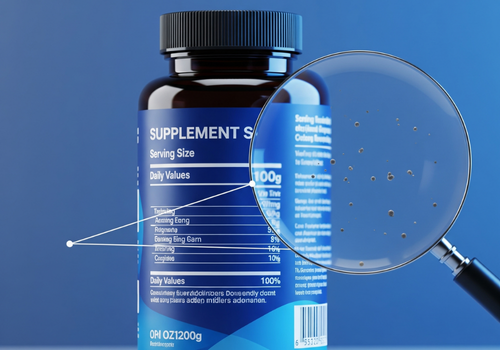Decode Supplement Labels on Amazon Like a Pro: What to Look For and What to Avoid in Products
Understand the Supplement Facts Panel First
The supplement facts label is the single most important element of any product. It lists active ingredients, dosages, and serving size — the details that determine a supplement’s true value. Look for transparency: every ingredient should be clearly listed with exact amounts. Be cautious of “proprietary blends,” which group several ingredients together without disclosing how much of each is included. This tactic allows brands to use impressive-sounding ingredients in small, ineffective quantities. A high-quality supplement will always provide full disclosure so you can verify potency and therapeutic relevance.
Evaluate Dosage Accuracy and Clinical Relevance
A supplement may contain the right ingredients but still be ineffective if dosed too low. For example, while Ashwagandha is commonly recommended for stress relief, the effective clinical dose is 300–600 mg of KSM-66 extract — yet many products include just 50–100 mg to save costs. The same applies to ingredients like CoQ10, L-Theanine, or Magnesium. When reviewing labels on Amazon, compare the dosages to research-backed guidelines. If the product doesn’t meet these ranges, it likely won’t deliver real benefits, no matter how positive the reviews or ratings appear.
Identify Ingredient Forms That Matter
Not all ingredient forms are created equal. High-absorption or bioavailable forms are more effective and better tolerated by the body. Look for premium forms such as Magnesium Glycinate instead of Magnesium Oxide, or Methylated B-vitamins (like methylcobalamin or methylfolate) rather than synthetic forms (like cyanocobalamin). Likewise, Ubiquinol is the superior form of CoQ10, and Omega-3 supplements should be in triglyceride form rather than ethyl ester. Supplements on Amazon that include these bioavailable forms often indicate a higher level of product integrity and scientific formulation.
Check for Third-Party Testing and Quality Certifications
Reputable supplement brands showcase third-party testing for purity, potency, and safety. Look for seals from NSF Certified for Sport, USP Verified, or Informed-Sport. These certifications confirm that the product has been tested for contaminants, heavy metals, and accurate labeling. Many low-cost or unknown Amazon brands skip this critical step and may include fillers or adulterated substances. Products without any third-party testing should be viewed skeptically. If the label or listing doesn’t mention testing or provide a Certificate of Analysis (COA), it’s better to skip the product.
Avoid Artificial Additives, Fillers, and Allergens
When reading labels, pay close attention to the “Other Ingredients” section. Low-quality supplements often contain artificial colors, flavors, binders, titanium dioxide, hydrogenated oils, and unnecessary sweeteners. These additives offer no health benefit and may even irritate the gut or cause allergic reactions. Look for clean-label products with minimal excipients, and verify whether the supplement is non-GMO, gluten-free, dairy-free, and free from artificial preservatives — especially if you have sensitivities. Vegan and allergen-conscious supplements often mark these clearly both on the label and in the product description.
Spot Red Flags in Claims and Descriptions
Amazon listings are full of exaggerated or misleading claims. Avoid products that promise instant results like “Lose 10 kg in a week” or “Cure your insomnia overnight.” Legitimate supplements work gradually and support your body over time — not as miracle cures. Also, be cautious of labels that say “Natural” or “Doctor-Formulated” without backing it up with science or credentials. Instead, look for references to clinically studied ingredients, real scientific research, and products backed by healthcare professionals or reputable medical bodies.
Understand the Role of Daily Values
The % Daily Value listed on supplement labels helps consumers understand how much of each nutrient a product delivers based on a standard daily requirement. But sometimes, these values can be misleading. For example, 5,000% of your daily vitamin B12 may seem impressive, but excessive doses aren’t always beneficial or necessary. On the other hand, low DV in something like Vitamin D3 may not be effective at all for immunity support. Learn to compare %DV to your actual health needs and ensure the dosage aligns with your goals, not just flashy numbers.
Read Reviews with a Critical Eye
Once you’ve reviewed the label, take a moment to explore the product reviews — but read them with discernment. Look for verified purchase reviews with detailed feedback rather than vague one-liners. Be wary of products with thousands of five-star reviews that lack real content, as these could be artificially inflated. Detailed reviews that mention side effects, results after consistent use, or comparisons with other supplements tend to be more trustworthy. Amazon has improved its detection of fake reviews, but skepticism is still your best tool.
Cross-Reference the Brand’s Website
Many supplement brands on Amazon have their own websites, where they offer deeper insights into their sourcing, testing, certifications, and ingredient philosophy. If a brand doesn’t have a professional-looking website or doesn’t provide additional transparency, that’s a red flag. Look for companies that clearly explain their manufacturing standards, third-party testing protocols, and where their raw ingredients are sourced from. Amazon listings are often limited, but the real truth lies in how much the brand is willing to reveal when not under pressure from platform algorithms.
Conclusion:
Decoding supplement labels on Amazon is the key to buying safe, effective, and suitable health products. With a better understanding of how to analyze ingredient dosages, bioavailability, certifications, and formulation transparency, you can avoid hype-driven or ineffective products and invest in supplements that truly support your wellness journey. As the marketplace becomes more crowded, label literacy becomes your strongest tool. By reading smart and shopping informed, you protect your health and your wallet — and ensure you’re putting only the best into your body.

